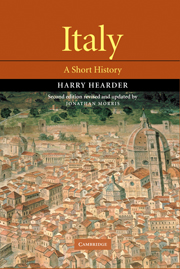Book contents
- Frontmatter
- Contents
- List of illustrations
- Preface
- 1 Italy in the classical world
- 2 The early Middle Ages
- 3 The high Middle Ages
- 4 The Renaissance
- 5 The political and cultural eclipse of Italy
- 6 The Risorgimento, 1790–1861
- 7 From Unification to Fascism, 1861–1922
- 8 The Fascist disaster, 1922–45
- 9 Italy since the Second World War, 1945–80
- Epilogue: From the First to the Second Republic: Italy 1980–2001
- A brief guide to further reading
- Index
8 - The Fascist disaster, 1922–45
Published online by Cambridge University Press: 05 February 2015
- Frontmatter
- Contents
- List of illustrations
- Preface
- 1 Italy in the classical world
- 2 The early Middle Ages
- 3 The high Middle Ages
- 4 The Renaissance
- 5 The political and cultural eclipse of Italy
- 6 The Risorgimento, 1790–1861
- 7 From Unification to Fascism, 1861–1922
- 8 The Fascist disaster, 1922–45
- 9 Italy since the Second World War, 1945–80
- Epilogue: From the First to the Second Republic: Italy 1980–2001
- A brief guide to further reading
- Index
Summary
The establishment of the dictatorship, 1922–9
The general elections of May, 1921, were held among scenes of great violence. About a hundred people were killed. In spite of controlling whole areas, and smashing up socialist meetings, the Fascists won only thirty-five seats. The outward trappings of Fascism, like the black shirt and the Roman salute, were already being adopted, and were giving the movement some spurious glamour.
There were short-lived governments, under Ivanoe Bonomi (from July 1921 to February 1922) and Luigi Facta (from February to October, 1922). These Liberal leaders could not agree to form a coalition together, nor with Giolitti. Nor did they have any success in forming a coalition with the Socialists, or with the democratic Catholic party, now known as the Popolari. It is easy in retrospect to say that a coalition of all democratic parties should have been formed to keep the Fascists out, and that it would have been comparatively easy to have done so, but no one in 1922 knew, of course, that a Fascist regime would survive for twenty-three years, and bring immense suffering and disaster to Italy.
In 1921 Italian Socialism began its long tradition of splitting into contending groups. Lenin had recommended that the Italian Socialist Party (the Partito Socialista Italiano) should change its name to the ‘Communist Party’. At the party congress in January 1921 about a third of the members, including Bordiga and Gramsci, voted to accept Lenin's advice, and the Italian Communist Party (the Partito Communista Italiano) was born, with Gramsci's Ordine Nuovo as its daily newspaper.
- Type
- Chapter
- Information
- ItalyA Short History, pp. 225 - 243Publisher: Cambridge University PressPrint publication year: 2001

